By CINDY SALO
Guest Columnist
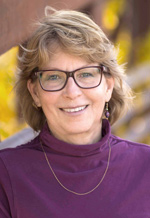 Dozens of people gathered at the Sheridan Historical Society Museum on Saturday morning, July 29, to learn about farmland preservation. I organized the event to learn how to protect my great-great-grandfather’s farm.
Dozens of people gathered at the Sheridan Historical Society Museum on Saturday morning, July 29, to learn about farmland preservation. I organized the event to learn how to protect my great-great-grandfather’s farm.
We were disappointed to learn that the American Farmland Trust (AFT) ranks Indiana in the top 10 states in projected loss of highly productive farmland by 2040, and in the bottom 10 for its response to this loss.
Farmland is being converted to other uses nationwide. Between 2001 and 2016, an area equal to all the land in the country used in 2017 to grow fruits, nuts, and vegetables – the things we love to eat right off the farm – was lost to agriculture.
While the conversion of agricultural land is widespread, responses vary around the country. Some communities value the green space, wildlife habitat, local farm products, and contributions to quality of life enough to help farmers protect their land. People in other areas ignore the problem and simply mourn the lost farmland.
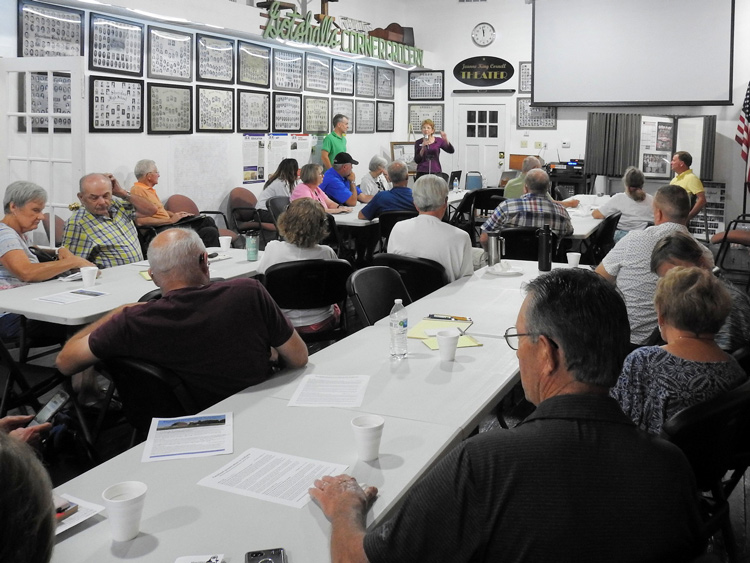
Dozens of people gathered at the Sheridan Historical Society on July 29 to learn about farmland preservation. (Photo by Steve Martin)
Nearly 30 states (Indiana is not one) protect farmland by paying eager landowners to permanently separate the development rights from their land. The owners keep all their other rights: they can continue to farm, pass the land to heirs, or sell it to other farmers. Farmland without development rights costs less than unrestricted land, which makes it easier for other farmers to buy. The document that severs development rights from farmland is an agricultural conservation easement (ACE).
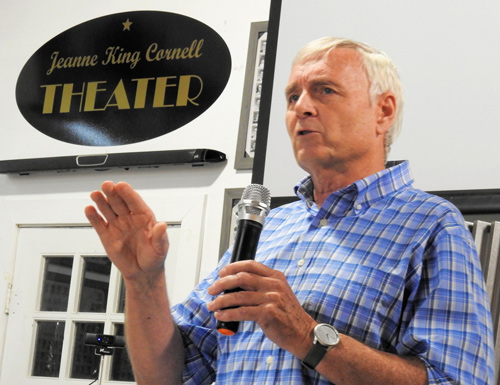
Mike Yoder, President of the Wood-Land-Lakes Land Trust, shares ideas on farmland preservation. (Photo by Steve Martin)
One of our speakers in Sheridan was Mike Yoder. Yoder has worn many hats during his career, which has included 16 years as an Elkhart County commissioner, 18 years with the county Economic Development Corporation, and close to 40 years’ experience in land use. He has also been a dairy farmer and a crop farmer and was instrumental in starting the Wood-Land-Lake Land Trust (WLL), where he serves as President. WLL helps farmers throughout Indiana preserve their land with ACEs.
Everyone who has protected land with WLL voluntarily gave up the development rights; none has been paid for these rights. Yoder said, “Everyone talks about preserving farmland, but nobody wants to pay farmers to do that. They just want farmers to reduce their retirement income by donating the value of an easement. That’s not fair and that’s not right.”
He continued, “We need to figure out a way to connect preserving farmland with the desire to create and sustain vibrant communities. Farmers donating conservation easements are contributing significant value to their community, which enhances the quality of place and life. I am not aware of a single community in Indiana that recognizes this charitable contribution.”
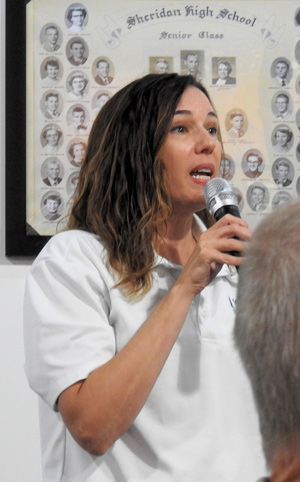
Beth Clarizia, Indiana Easement Program Manager with the Natural Resource Conservation Service, describes the agency’s Agricultural Land Easement program. (Photo by Steve Martin)
Another speaker, Beth Clarizia, described a “vast opportunity” to protect farmland in the state through the federal program she manages. The Agricultural Land Easement (ALE) program of the Natural Resource Conservation Service (NRCS) pays up to half the value of ACEs on qualified land. Some states will pay farmers the other half of an easement’s value; Indiana does not. Clarizia pointed out that the state is missing out on a large pot of federal money that could be tapped if there were a source of matching funds.
In the last session of the General Assembly, Representative Kendell Culp (R-Rensselaer) sponsored two laws that address farmland preservation. The first directed the Indiana Department of Agriculture to determine where, why, and how much farmland has been lost in the state. The second created a Land Use Task Force to explore how Indiana can expand economically while also protecting farmland.
At the event in Sheridan, several people had questions about the recent purchase of thousands of acres of farmland for the LEAP business park near Lebanon in rural Boone County. Culp said that he also had questions but had gotten few answers. He was concerned about how water and power will be supplied to the site, and how that might affect area utilities and communities. He also noted that the purchase of the land had driven up farmland prices in the area.
One person in Sheridan mourned the fate of small towns that “lose the grocery store, and then people are forced to leave the community.”
But this has the process backwards.
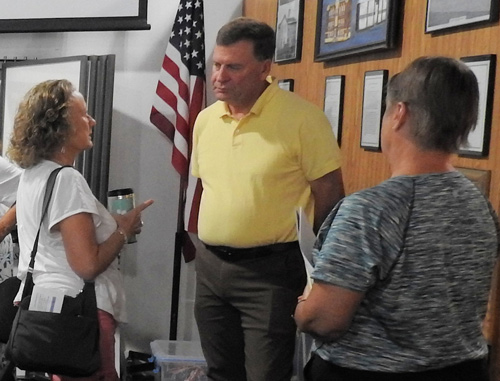
Indiana Representative Kendell Culp (R-Rensselaer) answers questions about farmland preservation after an event on the topic at the Sheridan Historical Society Museum. (Photo by Steve Martin)
Small town businesses don’t want to close. Residents leave the community to shop, which forces the businesses to close. Farmers don’t want to sell to developers. Developers outbid other buyers when cash-poor, land-rich farmers want to retire.
Grocery stores and farmland both enhance the quality of life in a community. Many towns have already lost their grocery store, but many still have abundant farmland. We can protect our remaining farmland by paying willing farmers to separate development rights from their land.
If you want to see farmland preserved to enhance the quality of life in your area, consider asking your Indiana legislators what they’re doing to protect farmland.
Cindy Salo is a plant ecologist who studies army cutworms in the intermountain west and writes about research and agriculture from rural Idaho and Arizona. Find more about Cindy and Indiana farmland preservation at CindySalo.com.

